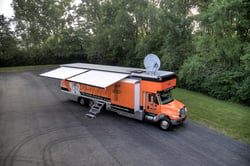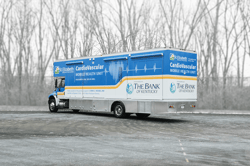Regardless of the pandemic there has always been an urgent need for adaptable healthcare interventions for the underserved. Interventions that improve health outcomes and address the inequality for those on the fringes of society. The topic of health equity always comes around to: “Meet people where they are”. This refers to bringing accessible healthcare to people where they live and work, and most particularly to the urban and rural poor. However, regardless of this general consensus, much of the medical community has yet to embrace the most useful instrumentality of meeting people where they are with Mobile Medical Clinics.
Even the most cursory study into the impact of mobile clinics exemplifies the value of readily accessible care to underserved populations. The cost savings to the healthcare industry as a whole, simply by the reduction of ER visits and early diagnoses that comes from utilizing mobile clinics, cannot go understated. Add in the additional revenue stream of mobile unit referrals to the home institution and it would seem most hospitals, healthcare institutions or university health systems would leverage the opportunities afforded by mobile medical clinics. As for the value to the underserved patient these units eliminate barriers to access, help to bridge trust with the system and improves health outcomes.
According to Mobile Health Map’s new website: “there are an estimated 2,000 mobile clinics in the U.S.” A number that has remained unchanged for more than six years. Perhaps this is an indicator that many institutions should take a more serious look at instituting a mobile health clinic program.
In this blog we will focus on how mobile medical clinics encourage preventative care with health screenings.
Mobile Medical Clinics Provide Cancer Diagnoses with Nuclear Medicine
Radiopharmaceuticals, also referred to as nuclear medicine, uses radioactive tracers to diagnose many types of cancers including:
|
|
|
In diagnostics, these “tracers” move to the organ to be studied. The tracers then give off energy as gamma rays, where a gamma camera detects the rays with the help of a computer. The system than produces measurements and images of the organ and adjacent tissues for review by the health care provider.
provider.
Many patients are concerned about the safety of nuclear medicine procedures. Though as any medical professional who works in the field knows the radiotracer and radiation dose are carefully selected to ensure the minimum radiation exposure and maximum accuracy. The radiation exposure in a nuclear medicine test is about the same as common diagnostic X-rays.
Populations in rural and urban areas are confronted by significant disadvantages to access for cancer screenings and diagnosis due to socioeconomic deprivation which limits their quality of care. The risk factors of cancer for residents of rural and urban areas are further exasperated due to their tendencies to engage in riskier health behaviors and having lower adherence to preventive care compared to suburban population segments.
What many professionals and prospective patients are not aware of is the capability of having mobile medical  units that can provide nuclear medicine cancer screenings of all kinds. These mobile units travel to rural and urban areas to conduct cancer screenings that provide accurate and early detection information about the structure and function of the body. As opposed to imaging exams, such as X-rays, MRIs, or CT scans which may not detect early diagnoses, nuclear medicine is the most advanced diagnostic method in obtaining functional information about a body’s internal organs and brain.
units that can provide nuclear medicine cancer screenings of all kinds. These mobile units travel to rural and urban areas to conduct cancer screenings that provide accurate and early detection information about the structure and function of the body. As opposed to imaging exams, such as X-rays, MRIs, or CT scans which may not detect early diagnoses, nuclear medicine is the most advanced diagnostic method in obtaining functional information about a body’s internal organs and brain.
The ability to bring advance cancer screening diagnostics to those on the fringes with mobile clinics is a game changer in providing balanced societal healthcare. Mobile health units are unique in increasing access, improving health outcomes, and building trust in urban communities, rural areas, and Indian reservations.
Cardiovascular Screenings with Mobile Health Units
It’s commonly known that heart disease is the leading cause of death in the U.S., and cerebrovascular disease such as strokes is not far behind at fifth, each of which typically strike without warning.
Cardiovascular diseases attack the blood vessels in the heart, and cerebrovascular disease affects blood vessels in the brain, each caused by the same risk factors. And each can be diagnosed with the same procedures. Mobile health units for cardiovascular testing provide risk assessments, complete screenings and education, and help to significantly reduce the risks of these diseases among disenfranchised populations. Reducing the risk of stroke alone, which can render a person permanently immobile or worse, can save the healthcare system untold long-term costs.
vessels in the brain, each caused by the same risk factors. And each can be diagnosed with the same procedures. Mobile health units for cardiovascular testing provide risk assessments, complete screenings and education, and help to significantly reduce the risks of these diseases among disenfranchised populations. Reducing the risk of stroke alone, which can render a person permanently immobile or worse, can save the healthcare system untold long-term costs.
Cardiovascular disease detection performed in mobile vehicles can detect abnormalities and determine risks for:
|
|
|
Conclusion
As with mammography screenings, the means for mobile units in seeking patients with symptoms of heart disease or signs of cancer is to find patients who need the treatments or preventive measures. And ensure the patients stay within the scope of your organization’s mobile unit goals by connecting with them in a way that is effective for your objectives. This is an added revenue stream that enables your hospital to offset other operating costs that you encounter.
Preventative health screenings are vital to a person’s long term wellbeing. Particularly for those over 45 years old. And the physical and financial burdens on the healthcare community from undiagnosed illnesses with the rural and urban poor are tremendous. And there may be no other way to reach them except to “meet them where they are”.
In June of 2022 Deloitte reported “inequities in the US health system cost approximately $320 billion and could eclipse $1 trillion in annual spending by 2040 if left unaddressed.” These inequities limit underserved people access to affordable quality care and generates avoidable financial waste across American society. Medicaid may pick up the cost of healthcare for the underserved that we see on the surface. But we shouldn’t be fooled. That cost trickles up to the entire cost of the insurance market, affecting the middle and upper class’s taxes and cost of healthcare. If we can’t provide adequate healthcare to the underserved for noble reasons, then for no other reason look at our own pocketbooks.
Click here to learn more about how mobile clinics provide vital cancer and cardiovascular screenings.
Sources Include:

